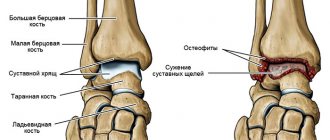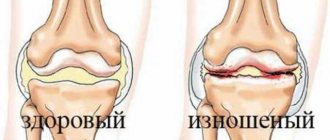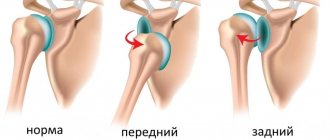The ankle is part of the ankle joint. It is also often called the ankle. Visually, this is a recognizable bone on both sides of the foot above the heel. The ankle at the ankle joint is the area where the ligaments are attached. When moving, it simplifies the turns of the foot and corrects the direction of movement. The ankle is the vulnerable part of the ankle. Increased loads can provoke its pathologies, and injuries also often occur.
Features of injury
Ankle injuries occur very often. First of all, they are associated with high loads that the joint of the foot and lower leg has to withstand during human movement. In most cases, when exposed to force, bone tissue is not destroyed, but partial or complete rupture of the ligaments occurs.
Only under high loads does the bone tissue break down, leading to a fracture. Typically, the risk of such injuries increases among professional athletes and people who engage in heavy physical work. Ankle fractures often occur when the ligaments of the ankle joint are weak.
To prevent ankle injuries, you should wear comfortable shoes. Constantly wearing high-heeled shoes causes problems. A sedentary lifestyle and sedentary work weaken the ankle ligaments.
Questions from patients about swelling of the ankles
My ankle hurts when I walk outside, which doctor should I contact?
If your ankle hurts when walking outside, you should consult an orthopedic doctor. It is very likely that you have a pathology of the ankle joint.
The ankles on the left leg are swollen, what could be the reasons?
The reasons why the ankles on the left leg swell may be the following: chronic venous insufficiency, venous thrombosis, injury or other pathology of the ankle joint.
My ankles are swollen, what should I do?
If your ankles are swollen, you should seek medical help from an orthopedist and phlebologist.
How to get rid of swelling of the legs?
To get rid of swelling of the legs, you need to undergo a medical examination. I recommend starting with a visit to a cardiologist, phlebologist and orthopedist.
Ligament damage
When sprained during movement, damage to the ankle ligaments occurs. In severe cases, their complete or partial rupture may occur.
Damage to the ankle ligaments in the ankle area is always accompanied by micro-tears of the connective tissue. Because of this, hemorrhages and accumulation of intercellular fluid occur, which leads to pain. They intensify when walking and standing for long periods of time.
Minor sprains can occur from walking for long periods of time without twisting or impacting the foot. The risks increase if people lead a sedentary lifestyle. The following signs indicate significant ligament damage:
- Swelling of the ankle, and in severe cases of the entire lower leg.
- Loss of ankle mobility.
All about an ankle fracture
The most common ankle injury is a fractured ankle.
Such damage limits motor activity and disrupts the usual way of life; moreover, untimely treatment and an irresponsible approach to rehabilitation can cause serious complications. To avoid adverse consequences, you should immediately take action, properly organize orthopedic treatment and begin rehabilitation.
Where is the ankle?
The ankle is a bilateral bony process of the lower leg, consisting of an outer (lateral) and inner (medial) ankle.
The lateral ankle is the distal end of the fibula, which forms the tibia. The tibia is adjacent to the inner one. They run parallel to each other and form an “angle” located at the junction of these parts. Visually, the ankle is a bony tubercle on both sides of the ankle.
The ankle is the most important part of the ankle, serving as a stabilizer. Due to high mechanical loads, it is most vulnerable to damage.
What can cause a broken ankle?
- severe blow or bruise
- rolled foot
- falling from a height or on an unstable surface
Symptoms of an ankle fracture
- Immediately after the injury, sharp pain appears, partially limiting the mobility of the leg or completely blocking it
- swelling forms at the site of injury
- hematoma and deformation appear
- maximum pain in the region of 3-4 cm above the ankle
- diffuse bruises are observed when bone fragments are displaced
- an “angle” appears between the lower leg and the distal limb
- pathological mobility occurs
- a characteristic crunch is clearly audible when moving the limb
The severity of symptoms directly depends on the complexity of the fracture and ligament damage.
Types of ankle fractures
The tibiofibular syndesmosis is a bony joint consisting of three ankle ligaments.
Damage in the area below the syndesmosis
- isolated damage
- disruption of the medial malleolus
- violation of the integrity of the posteromedial edge
Damage to the fibula at the syndesmosis level
- isolated fracture
- with medial injuries
- damage to the medial part and fracture of the posterolateral edge
Damage in the area above the syndesmosis
- simple diaphyseal fracture of the fibula
- comminuted diaphyseal fracture of the fibula
- proximal fibula fracture
Diagnosis of a fracture
To confirm a fracture, the following diagnostic methods are used:
- X-ray of the ankle in two projections
- CT scan
- Angiography
- MRI (the most informative and safe technology)
Treatment
There are two types of treatment for an ankle fracture:
- conservative
- operational
To determine the optimal treatment tactics, it is necessary to take into account the characteristics of the injury, age, gender and the presence of pathologies.
Conservative treatment of ankle fractures
Treatment consists of manual anatomical restoration of the damaged joint, complete immobilization and treatment of damaged ligaments.
Conservative treatment is indicated for non-displaced ankle fractures, as well as for severe concomitant diseases or poor condition of soft tissues, when surgery is contraindicated.
Conservative methods include:
- manual reposition of fragments
- application of fixing plaster bandages
- immobilization with rigid orthoses
- wearing orthopedic braces
Surgical treatment of ankle fractures
Surgery is appropriate for complex open fractures, displaced fractures, and significant internal soft tissue injuries.
The operation should occur no later than 8 hours after the injury, before tissue swelling occurs. Otherwise, surgery should be postponed until the swelling subsides. Before surgery, the fracture should be fixed with a cut plaster cast or skeletal traction.
In both cases, rehabilitation is accompanied by medication to relieve pain, relieve inflammation and prevent thrombosis.
Rehabilitation
Thanks to rehabilitation measures, it is possible to restore joint mobility, restore shape and eliminate the development of complications. A competent and responsible approach to rehabilitation, a well-designed plan of specially selected exercises will help you recover much faster and return to your previous full-fledged lifestyle after such a serious injury.
Neglecting these recommendations risks improper fusion of fragments, which can have serious consequences: false articulations, frequent subsequent dislocations, lameness, flat feet, as well as possible persistent pain and the development of deforming pseudarthrosis.
Recovery time
The time it takes to achieve the first improvements, if all recommendations are followed, directly depends on the complexity of the injury:
- non-displaced fracture – 1 week
- displacement injuries and manual fracture reduction – 2 weeks
- after surgery to reduce fragments – 3 weeks
- 2 months after avulsion of the edge of the tibia
On average, a simple fracture heals completely in 2.5 months.
For a displaced fracture, a minimum of six months is required. You can begin to develop your leg without crutches 3 months after the fracture. The issue of returning to a normal lifestyle is decided individually. For example, you can return to sports only two years after the injury.
An alternative to casting for ankle fractures
For many years, the use of plaster was the gold standard in traumatology, but the heavy and completely non-breathable material practically does not transmit x-rays, and this makes it much more difficult to control the rehabilitation process. Wearing a cast is accompanied by severe itching, and the heavy weight unnecessarily loads the already injured limb. The combination of these factors gave impetus to the search for new technologies in the treatment of such injuries.
Orthoses for ankle fractures
In modern medical practice, an alternative method to fixation of injured limbs – orthoses – is increasingly being used as an alternative to plaster.
The method is based on wearing a special orthopedic product at the site of a bone fracture, dislocation, or soft tissue injury, to restore their previous functionality.
The choice of ankle orthosis for ankle fractures depends on the stage of the process. In the acute period, the doctor’s choice will be on a rigid orthosis, which will eventually be replaced by a semi-rigid one, and then an elastic one.
Orthosis functions:
- complete or partial immobilization
- direction or restriction of movement
- reducing the load on the damaged area
- prevention of secondary damage during early cast removal
- shape correction
- facilitating movement or relieving pain
Indications for the use of ankle orthoses
Direct indications for the use of orthoses include:
- fractures in the ankle area
- sprains and subluxations in the ankle area
- ligament injuries of varying complexity
- a whole range of inflammatory and degenerative diseases
- ankle instability
- childhood congenital anomalies, rickets and others
- prevention of injuries in athletes and overweight people
Types of ankle orthoses:
- Rigid
(degree of fixation: full)
After fractures, long-term immobilization of the joint is necessary.
A rigid orthosis copes well with the task of long-term complete immobilization of the joint. Such an orthosis promotes proper bone healing so that motor function is restored to the fullest extent. The orthosis is a comfortable, breathable design that visually resembles a boot with zippers or Velcro.
- Semi-rigid
(degree of fixation: strong)
The use of a semi-rigid orthosis is necessary during the rehabilitation period after injury.
which allows you to treat not only fractures, but also other diseases of the bone and joint systems. Used for Achilles injuries and ligament damage. This orthosis fits into everyday shoes.
- Elastic
(degree of fixation: light, medium)
Used by athletes to prevent joint injuries.
Such models are comfortable for everyday wear as they do not cause discomfort. The bandage will help provide additional support to the ligaments and joints during intense exercise, thereby minimizing the likelihood of damaging them. If you often run, play football, volleyball or other active sports, such devices are simply irreplaceable for you.
Fractures
Ankle fractures can occur for a variety of reasons. Direct injuries occur upon impact. Most often, this occurs during an accident when a heavy object accidentally falls on the leg. Indirect fractures are more common. They usually occur when the leg twists. In this case, the injury is accompanied by the formation of bone fragments and dislocation of the foot and sprained ligaments. As a rule, it occurs when falling on ice or a slippery floor, walking on an uneven surface, etc.
If the fracture did not cause displacement of bone fragments and severe sprain of the ligaments, then swelling and tolerable pain are noted against the background of difficulties with joint mobility. In more severe cases, there is intense pain and an absolute inability to step on the injured leg. In addition to swelling, bruising is often present in the ankle area. With an open fracture, there is a wound through which bone fragments are visible.
Posterior ankle fracture.
Most often occurs in combination with a fracture of the lateral malleolus or as part of a trimalleolar fracture. Surgical treatment is indicated when more than 25% of the area of the supporting plateau of the tibia is involved, and displacement is more than 2 mm. Most often, fixation with screws is used; if the displacement can be eliminated closed, the screws are installed from front to back; if open reduction is performed from the paraachilles approach, then the screws are installed from the back to the front; it is also possible to use an anti-slip plate installed proximally.
Features of treatment
If, after examination by a doctor and diagnostics, minor ligament damage is confirmed, then it is necessary to ensure maximum rest for the sore leg. Cold compresses are indicated. Ice is applied to the sore spot during the first 24 hours after injury. If necessary, painkillers are prescribed and orthoses are worn to fix the ankle. In severe cases, when the ligaments are torn, surgical treatment is performed.
In case of a fracture, a plaster cast is required. Strong painkillers are prescribed to relieve pain. If bone displacement is confirmed, surgery is performed. An ankle fracture requires professional treatment. Otherwise, foot function may be impaired.
With correct treatment, it will take 6-8 weeks for the bones to heal in an ankle fracture. During this period it is necessary to wear a cast. You should also avoid any stress on the injured leg. After the cast is removed, you will need to wear special shoes for a certain time and periodically take x-rays to monitor the recovery. The duration of complete rehabilitation usually takes about a year. During the recovery period, calcium-rich foods should be included in the diet. Massage and physical therapy are also indicated.
Bimalleolar fracture.
This group includes both a fracture of the outer and inner ankles and a functionally bimalleolar fracture - a fracture of the outer malleolus and a rupture of the deltoid ligament. In most cases, surgical treatment is indicated. A combination of neutralizing, bridging, anti-slip plates, and compression screws is often used.
Osteosynthesis of a fracture of the outer malleolus using a compression screw and a neutralizing plate installed on the outer surface of the fibula, osteosynthesis of a fracture of the inner malleolus with two compression screws.
If the distal tibiofibular syndesmosis is damaged, which often occurs with suprasyndesmotic (high) fractures of the fibula, installation of a positioning screw is indicated for a period of 8-12 weeks with the complete exclusion of axial load.
When treating a functional bimalleolar fracture, there is no need to suture the deltoid ligament if it does not interfere with reduction, that is, if the position of the talus is satisfactory. When it is tucked into the joint cavity, it is impossible to eliminate the subluxation closed; for this reason, access to the inner ankle is performed, removal of the joint block and suture of the deltoid ligament.
Swelling of the ankles
A fairly common pathological condition is swelling of the ankles. They occur without exposure to any traumatic factor. In most cases, this is due to excess weight and a sedentary lifestyle. Due to increased stress, edema often occurs during pregnancy. When such symptoms appear, it is important to dose out physical activity and drink less fluid.
Swelling of the ankles can be a symptom of various diseases: heart, kidney and liver. In addition, urinary tract infections are a common cause of pathology. Swelling of the ankles may indicate the onset of venous insufficiency. In this case, after a certain time, changes in the appearance of the skin will appear, and in severe cases, ulcers will appear and the risk of infection will increase.
If swelling of the ankles occurs, you should immediately contact your local physician. To treat swelling of the ankles, the cause of the pathological condition must be established. After this, measures are taken to treat the specific disease. In any case, therapeutic exercises can stabilize the condition. It is also important to wear comfortable orthopedic shoes when swelling occurs. For persistent swelling, herbal diuretics are prescribed. Foot baths and massage are recommended at night.
Causes of swelling of the ankles (ankles)
There can be many reasons why ankles (ankles) swell. Here is an example of just a few of them:
- Injuries to the foot or ankle
- Side effect of some medications
- Inflammation of subcutaneous fat (cellulite)
- Varicose veins complicated by chronic venous insufficiency
- Venous thrombosis
- Pregnancy
- Preeclampsia
- Pathology of the kidneys or liver
- Hypothyroidism
One of the main reasons why ankles (ankles) swell is varicose veins. With varicose veins, swelling is caused by disruption of the valves of the venous vessels of the lower extremities. These valves provide physiological return of blood to the heart. It is this mechanism that is damaged in varicose veins, resulting in reverse blood flow and blood stagnation in the distal parts of the lower extremities.
Ankle swelling at the end of the day
Decompensation of the condition leads to swelling of the ankles.
How does a fracture occur?
Ankle fractures, more commonly known as ankle fractures, occur when one or more of the bones that make up the ankle joint are broken. Although an ankle fracture is an injury seen at almost any age, it is more common among older adults and athletes who are physically active.
When the bones are damaged, the ankle becomes unstable. When adding ligament damage, the injury can become a very serious problem, and complications after an ankle fracture are possible.
An ankle fracture can be caused by a sudden, accidental movement, such as twisting the ankle during sports or activity. Car accidents can also cause ankle fractures, especially after hard impacts.
A person can also trip, fall, or twist an ankle, which can cause an ankle fracture. Depending on age and previous health conditions, this problem can develop into a much more serious injury if left untreatedSource: Ankle Injury Analysis. Taylashev M.M., Salatin P.P., Sobolev V.V., Pozikov V.V., Kolesnikov A.S. Acta Biomedica Scientifica, 2008. p. 144-145.
Possible complications
After treatment, it is important to follow your surgeon's instructions. Failure to do so can lead to infection, deformity, arthritis, and chronic pain. Source: Mistakes and Complications in the Treatment of Compound Ankle Fractures. Salikhov R.Z., Pankov I.O., Plakseychuk Yu.A., Soloviev V.V. Practical medicine, 2014. p. 128-131.
Article sources:
- Errors and complications in the treatment of complex fractures of the ankle joint. Salikhov R.Z., Pankov I.O., Plakseychuk Yu.A., Soloviev V.V. Practical medicine, 2014. p. 128-131
- Analysis of ankle joint injuries. Taylashev M.M., Salatin P.P., Sobolev V.V., Pozikov V.V., Kolesnikov A.S. Acta Biomedica Scientifica, 2008. p. 144-145
- Comprehensive diagnosis of ankle joint injuries. Kim L.I., Dyachkova G.V. Genius of Orthopedics, 2013. p.20-24
- Fractures of the ankle joint and treatment methods. Cherednik A.A., More Gautam Saherbao, Al-Fakih Abdulaziz. Bulletin of Medical Internet Conferences, 2014. p.432
- Therapeutic tactics for intra-articular fractures of the ankle joint (literature review). Zedgenidze I.V., Tishkov N.V. Acta Biomedica Scientifica, 2013. pp. 178-182
| Name of service (price list incomplete) | Price, rub.) | In installments* |
* You can read more about the conditions here - Treatment on credit or in installments.
Anatomy of the ankle joint
The ankle connects the bones of the foot to the bones of the lower leg. The ankles are the distal portions of the tibia and fibula.
The structure of the ankle is quite complex: it is formed by the talus and tibia bones, which are connected by cartilage and muscle tissue. Each joint has an extensive network of blood vessels and nerves, which provide tissue trophism and coordinated movement of the limb.
In the event of an injury, all this is disrupted and, if not treated correctly, is never fully restored.










